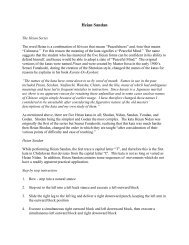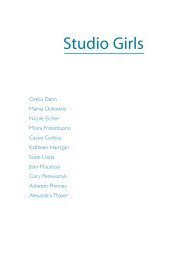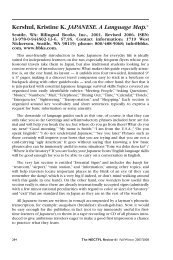selected paintings - Dickinson College
selected paintings - Dickinson College
selected paintings - Dickinson College
Create successful ePaper yourself
Turn your PDF publications into a flip-book with our unique Google optimized e-Paper software.
3<br />
Background of Metropolitan Industry, n.d.<br />
Oil on canvas, 32 x 39 1/2 in. (81.3 x 100.3 cm)<br />
Signed: l.r.: Quincy<br />
Exhibited: Spirit of the Past: The Paintings of Edmund Quincy, 1903-1997 (New<br />
York: Hirschl & Adler Galleries, 2000); Portrait of American Exhibition<br />
(New York: Artists for Victory, Inc., 1944).<br />
Published: Zachary D. Ross, Spirit of the Past: The Paintings of Edmund Quincy,<br />
1903-1997 exh. cat. (New York: Hirschl & Adler Galleries, 2000), 34,<br />
cat. 14.<br />
Courtesy of Hirschl & Adler Galleries, NYC<br />
In his Background of Metropolitan Industry, Edmund Quincy<br />
painted a diagonal in the form of a brown fence to direct the<br />
eyes of the viewer through the painting. The viewer starts to<br />
examine the painting from the lower left corner where two parts<br />
of the fence meet. From there, the viewer’s eyes follow the fence<br />
on the right, up past an old garden with trees, other vegetation,<br />
and some old trellises. At the end of the fence, the viewer’s eyes<br />
are taken across a horizontal row of old, broken, and neglected<br />
wagons. When the wagons run into the frame of the painting,<br />
the viewer is forced to move his or her eyes upward and take in<br />
the distant cityscape and surrounding industry indicated by a<br />
water tower and billowing white smoke. From there, the viewer<br />
takes in the wide open sky that covers and unifies the whole<br />
scene. This technique of using an angle to force the viewer to<br />
look at imagery in the way the artist wants him or her to is<br />
something Quincy used in many of his <strong>paintings</strong>, including<br />
Rural Landscape with Distant Church and Venice Canal.<br />
In Background of Metropolitan Industry, Quincy places the<br />
viewer in the role of a “spectator.” This technique is common<br />
practice by Quincy, and can be seen in his other <strong>paintings</strong>,<br />
including Street Scene, Boston, in which the viewer looks at a<br />
street scene from an elevated position, a banishment of the<br />
viewer to an observation point outside the image rather than a<br />
point within the scene. The viewer in Background of<br />
Metropolitan Industry is standing off center and to the left.<br />
Quincy has placed the viewer in this location in order to control<br />
the way he or she views the scene. It seems clear that<br />
Quincy intends the viewer to follow the fence so that it is seen<br />
as a progression of time.<br />
The first thing that the viewer sees is the garden, which is a<br />
small-scale form of agriculture. Next, the viewer sees the row of<br />
broken down wagons, objects that people have abandoned, perhaps,<br />
for something newer and more modern. Finally, there is<br />
the industrial city in the background, clearly a sign of what<br />
Quincy saw going on around him.<br />
Another aspect of this painting is Quincy’s use of framing.<br />
Quincy has a way of painting an image that looks as if it has<br />
been taken out of something larger. For instance, in Background<br />
of Metropolitan Industry, the scene looks like a still frame taken<br />
from a reel of film. In cinematic film, each frame comes together<br />
on the screen to form a whole scene; individually, however,<br />
10<br />
each frame is a photograph. These photographs are taken at<br />
very rapid speed so they can be combined to create a motion<br />
picture, and some frames capture unique angles, with figures<br />
and objects cut off, and interesting lighting effects. These<br />
unique details are perhaps what Quincy was trying to reproduce<br />
in his painting. A contemporary of Quincy, Edward Hopper,<br />
was said to “[carry] the main horizontal lines of the design with<br />
little interception to the edges of the picture…to enforce this<br />
idea and to make one conscious of the spaces and elements<br />
beyond the limits of the scene itself.” 1 This idea of the picture<br />
going beyond the frame can be seen in the horizontal line of the<br />
wagons. The line is abruptly interrupted by the frame of the<br />
painting, which even cuts one of the wagons in half on the right<br />
side of the scene. Quincy would have seen Hopper’s works, and<br />
also would have been aware of how motion picture film worked<br />
at the time. We know that Hopper looked at film for inspiration<br />
and, as Barbara Haskel noted, “He exploited the framing<br />
and lighting conventions of cinema…cropping his scenes offcenter.<br />
As a result, his canvases often register a frozen moment<br />
in a cinematic sequence.” 2 In Background of Metropolitan<br />
Industry, Quincy may have been thinking along the same lines<br />
as the image is framed off-center. Furthermore, there is no central<br />
figure, but rather a few objects that lead the viewer’s eyes<br />
from one side of the painting to the other, and the viewer<br />
almost expects the scene to go on, perhaps with more wagons or<br />
more of the city. Quincy’s <strong>paintings</strong> are framed in such a way<br />
that they seem like part of a bigger picture.<br />
Framing techniques were not the only things Quincy may<br />
have looked at in Hopper’s <strong>paintings</strong>. Hopper also used something<br />
called a “wedge design.” He would create a space, usually<br />
a room, which would have two walls that met at a point that<br />
was usually aimed towards the viewer, though not always. This<br />
technique allows the viewer to look in through both walls, or in<br />
one wall and out the other, but still allowing the artist to frame<br />
the space and give it depth. This technique can be seen in<br />
Hopper’s Nighthawks (1942). 3 In the scene, a waiter works<br />
behind the counter while three customers sit in a diner late at<br />
night. Hopper allows the viewer to look in on them through<br />
one window and then past them and out through the other<br />
window onto a dark street. The windows come to a point to<br />
create the “wedge” and in turn, the three-dimensional space of<br />
the diner area. Quincy also attempts “wedge design” with the<br />
two sides of fencing that meet at a point in the lower left corner<br />
of his painting. Quincy used fencing in the outdoors to create<br />
the wedge, so what we can see of the garden has not been<br />
altered, but depth has been created by the addition of the horizontal<br />
area of the fence.<br />
Hilary Smith<br />
1. Lloyd Goodrich, Edward Hopper (New York: Henry N. Abrams, 1993), 104.<br />
2. Barbara Haskell, The American Century: Art and Culture 1900-1950 (New York:<br />
Whitney Museum of American Art in association with W.W. Norton and Co., 1999),<br />
182.<br />
3. Goodrich, 106.






